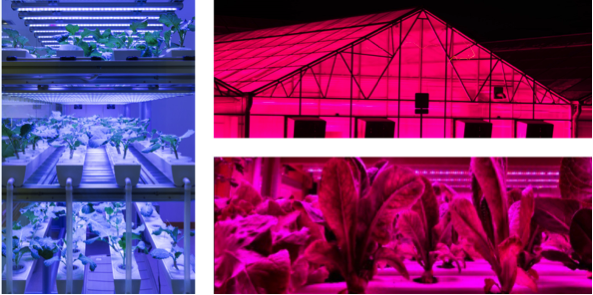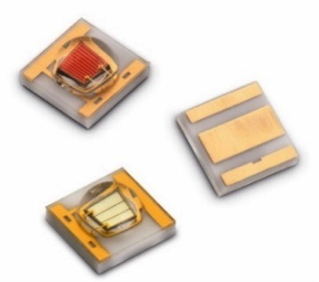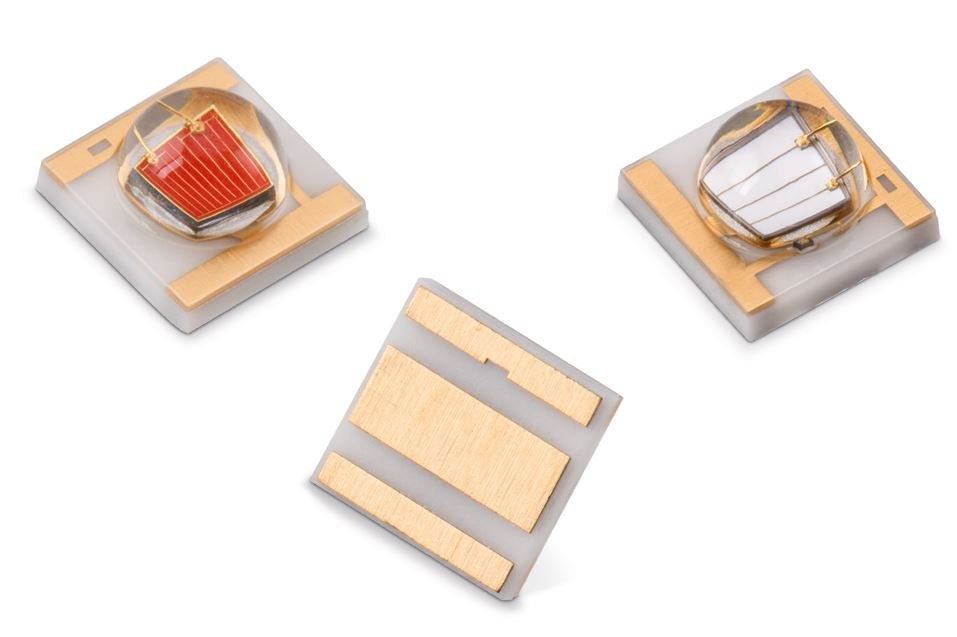LEDs – The Future of Horticultural Lighting
Greenhouse farms may not be a new technology but with an every growing world population and the move towards sustainability, intensive yet highly efficient and standardized food production will increasingly become the norm in future years opening a potentially huge new agricultural sector that incorporates the latest technologies from the bioscience and engineering fields. Advancements in lighting, heating, watering and control systems have allowed the construction of vast, artificially lit, indoor greenhouses.

Example of indoor greenhouse plant bed with LED light source
Compared to conventional agriculture, these installations can produce significantly larger yields. The different stages and cycles of plant development can be controlled by providing different wavelengths of light to gain greater yields or reduce growing times. Water usage is greatly reduced due to reduced evaporation and the control of humidity and temperature in the installation. The control or elimination of insectile, fungal or bacterial pests is also more effective because of the closed system. In addition, the carbon footprint of food production and supply can also be significantly reduced by building the installations close to population centers, reducing transport requirements. One of the most significant future advancements in the viability of indoor greenhouses has been the maturation of LED technology. Originally, LEDs were expensive and extremely limited in the wavelengths of light they could generate. However, as advancements in their fabrication have progressed, LEDs have become the preferred solution for indoor cultivation. LEDs can now be made to emit very specific bandwidths of light while being extremely rugged and relatively small when compared to other lighting technologies. In addition, LEDs have a long life, have low voltage requirements and do not generate as much excessive heat making them exceptionally efficient. This will greatly reduce the operating costs of indoor greenhouses.
However, it must be remembered that every type of plant will respond differently to various combinations of light wavelength and intensity. In addition, different physical characteristics are preferred for different types of plants. For example, it is desirable for salad vegetables to have thin, light leaves for improved texture when eating, whereas in Aloe vera thick leaves are desirable to produce more latex. Regarding flowering, decorative plants need to maintain their flowers for as long a duration as possible while in pineapples, it is optimum to inhibit the flowering process to better control the harvest period. As a result, indoor greenhouse operators and artificial light unit manufacturers are always looking for new combinations of wavelengths that are particularly catered to the light recipe of specific species and even cultivars (sub-species) of plants.
To meet these requirements, Würth Elektronik offers the WL-SMDC SMD Mono-color Ceramic LED Waterclear range of LEDs. The WL-SMDC range has been expanded to include wavelengths of 450 nm (Deep Blue), 660 nm (Hyper Red) and 730 nm (Far Red), which have been selected to match the absorption spectra of photosynthetic pigments. In addition to the existing products in the range, a diverse range of combinations is possible that can be catered to the target cultivar.

The emission spectra of WL-SMDC LEDs overlaid on the absorption spectra of photosynthetic pigments
The improvement in efficiency, optical power, price and life span have moved LEDs from the research stage of development to an innovative, viable alternative to conventional lighting sources in the application of horticulture. Although the exact influence of wavelength ratios and the role of wavelengths outside of red and blue needs to be investigated and understood, LEDs will continue to take market share from other lighting sources and will become dominant in the coming years. With the release of the extended WL-SMDC, Würth Elektronik has LEDs to match the wavelengths that are essential for photosynthesis in addition to any special requirements that may be required for specific types of plant.

Würth Elektronik WL-SMDC SMD Mono-color Ceramic LED Waterclear
About Würth
Würth Elektronik eiSos GmbH & Co. KG is a manufacturer of electronic and electromechanical components for the electronics industry. Manufacturing facilities in Europe, Asia and North America ensure delivery to a customer base that is growing worldwide. The product range covers EMC components, inductors, transformers, HF components, varistors, capacitors, power modules, LEDs, connectors, power elements, switches, assembly technology and fuse holders. Würth Elektronik eiSos is one of Europe's largest manufacturers of passive components.

